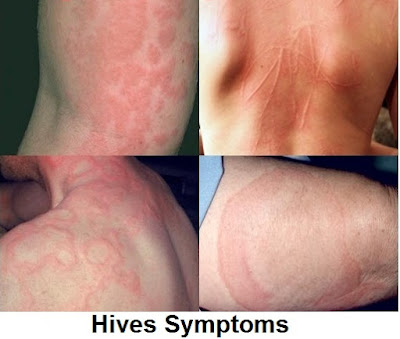What are hives?
Hives is an intense itchy rash. It is created in a short time, often within half an hour. It starts with red spots. It can then pass into thickened pale spots. The spots may coalesce into larger flat areas (hives), but that does not always happen. Hives are annoying, but usually not serious. The sites are often already gone after a few hours.
Hives can have many different causes. The "stimulus" can come from outside (eg, cold, heat, sunlight, fleas bite), but also from within, such as certain foods or medications. Due to these incentives the mote histamine in the body creates a sort of allergic reaction.
Hives often occurs. A quarter of the people get there early or late to do with it once. It is not proven that hives is hereditary, but in some families are more common than others.
Antihistamines are drugs that antagonize the action of the histamine mote. They can be used in hives, but often do not need any treatment.
How do you get hives on skin?
Often, the cause of hives is unclear. In 75% of people with hives is never found a cause.
It is clear that hives can be caused by various stimuli. There than antibodies or histamine are released from the cells of the body. Consequently the walls of the small blood vessels in the skin moisture. There then arose fluid collections under the skin.
What incentives can cause hives?
- drugs (especially analgesics, antibiotics and X-ray contrast agents);
- acute and chronic infections (especially caused by bacteria, viruses, and parasites);
- physical stimuli (exercise, local pressure on the skin, cold, heat, sunlight);
- food (eg fish, shrimp, egg);
- food additives (colorings, flavor enhancers, etc.);
- allergy to foods;
- allergies to inhaled products (mold spores, animal dander, etc.);
- insect bites and stabbing;
- diseases (metabolic diseases, autoimmune diseases);
- skin contact with certain materials (rubber, animal protein, plants, chemicals, etc.).
What are the signs and symptoms of hives?
Hives come in different forms and everywhere in the body. It can thus everyone something different like this:
- Itchy red bumps the size of a pinhead. This form occurs especially after exertion or stress and is called exertional hives.
- Large confluent disks that are thickened and lie on top of the skin. Such a disk is called a wheal.
- Itchy stripe-shaped bulges caused by friction or pressure (urticaria factitia). For example, these spots caused by pinching or rubbing of clothing. The spots disappear after some time again.
How does the doctor determine if you have hives?
Most doctors recognize hives easy. The doctor will work with you to determine the cause. If not, then this requires further study.
Investigations that may provide clarity:
- blood tests;
- X-rays;
- bacterial cultures;
- examination of urine and feces;
- allergy test;
- provocation test. In a challenge test, for example, you get to eat something that is likely to give a response. Many people have themselves already have an idea on what foods they react. Then again you get hives, you know whatever food it is.
What is the treatment for hives on skin?
Most easy way to get rid of hives is to avoid the stimulus that causes this reaction. Eg to stop taking a medication or avoid certain foods. Then of course they must know what to you the cause of hives is.
If the cause is not known, you get drugs that eliminate the allergic reaction (antihistamines). These drugs stop the action of histamine. Children can get these drugs in a drink. Adults usually get tablets.
If it looks as if the skin reaction with a few days has elapsed, an itch-relieving lotion is enough. The spots automatically go away.
There are also hormone and tar ointments to soothe the itching. Also, a lukewarm shower cools.
Wear loose clothing so that your skin can breathe freely.
Furthermore, for the healing important not to scratch the open spaces, even though that might be quite difficult. You can get at the pharmacy anti-itch. Rather drink no alcoholic drinks and try to avoid stress. The skin rash can namely be worse.



